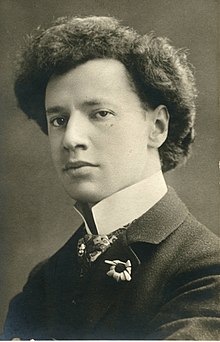Ossip Gabrilowitsch
Ossip Gabrilowitsch | |
|---|---|
 | |
| Born | 7 February [O.S. 26 January] 1878 |
| Died | 14 September 1936 |
| Occupation(s) | Pianist, conductor and composer |
| Spouse | |
| Signature | |
 | |


Ossip Salomonovich Gabrilowitsch (Осип Сoломонович Габрилович, Osip Solomonovich Gabrilovich; he used the German transliteration Gabrilowitsch in the West) (7 February [O.S. 26 January] 1878 – 14 September 1936) was a Russian-born American pianist, conductor and composer.[1][2]
Biography
Ossip Gabrilowitsch was born into a Jewish family in Saint Petersburg. His parents were Salomon Gabrilowitsch and Rose Segall.[1] [failed verification]
He studied the piano and composition at the Saint Petersburg Conservatory, with Anton Rubinstein, Anatoly Lyadov, Alexander Glazunov and Nikolai Medtner among others. After graduating in 1894, he spent two years studying piano with Theodor Leschetizky in Vienna.
In July 1905 he recorded ten pieces for the Welte-Mignon reproducing piano, one of the first pianists to do so. Between 1915 and 1927, he subsequently recorded at least fifteen more reproducing rolls for Duo-Art and at least five reproducing rolls for Ampico.
On 6 October 1909, he married Mark Twain's daughter Clara Clemens, a singer who appeared with him in recital. On 18 August 1910, their only child, Nina, was born at Mark Twain's home Stormfield in Redding, Connecticut.[3] Nina, the last known lineal descendant of Mark Twain, died on 16 January 1966 in a Los Angeles hotel. She had been a heavy drinker, and bottles of pills and alcohol were found in her room. Her death was ruled a suicide.[4]
From 1910 to 1914, he was conductor of the Munich Konzertverein (later known as the Munich Philharmonic). At the outbreak of World War I, he was arrested as an enemy national. Through the intervention of the nuncio to Bavaria, Archbishop Eugenio Pacelli (later Pope Pius XII), Gabrilowitsch was freed from jail, and then he headed to the United States[5] via Zürich in August 1914.[6]
He settled in the US, and was offered the post of conductor of the Boston Symphony Orchestra. In declining, he recommended that the Boston board appoint the recently arrived Sergei Rachmaninoff. In 1918 he was appointed the founding director of the Detroit Symphony Orchestra, while still maintaining his life as a concert pianist. Before accepting the conductor's position, he demanded a new auditorium be built, and this was the impetus for the building of Orchestra Hall.
Gabrilowitsch composed a few works, primarily short piano pieces for his own use. He was a National Patron of Delta Omicron, an international professional music fraternity.[7]
He died from stomach cancer on September 14, 1936, in Detroit, Michigan.[1][8] He is buried in the Langdon plot of the Woodlawn Cemetery in Elmira, New York.
Works
- 5 Klavierstücke, Op. 1
- No. 3 Valse lente (c. 1897)
- Gavotte in D minor, Op. 2
- Compositions for the piano, Op. 3
- No. 1 Caprice Burlesque (ca 1901)
- No. 2 Mazurka Mélancolique
- Thème varié pour piano, Op. 4
- Mélodie, Op. 8, No.1
- La Czarina, Mazurka Russe (The Tsarina, Russian Mazurka)
- Three Songs, Op. 11:
- No. 1 Good-bye (Christina Rossetti)
- No. 2 I love her gentle forehead (Richard Watson Gilder)
- No. 3 The new day (R. W. Gilder, c. 1917)
- Two Piano Pieces, Op. 12
- No. 1 Elegy
- No. 2 Etude for the left hand
- Near to thee ... [Song] Poem by Johann Wolfgang von Goethe, English version by Clara Clemens (ca. 1924)
Literature
- Clara Clemens: My husband Gabrilowitsch. Reprint of the ed. published by Harper, New York. New York, NY: Da Capo Press, 1979. ISBN 0-306-79563-9
- Cooke, James Francis: Great Pianists on Piano Playing: Godowsky, Hofmann, Lhévinne, Paderewski and 24 Other Legendary Performers. New York (Dover) 1999. (Reprint of the original edition 1917).
- Ossip Gabrilowitsch: Essentials of Touch. In James Francis Cook: Great pianists on piano playing: study talks with foremost virtuosos. Publisher: Theo. Presser & Co., Philadelphia 1917, page 122
Media
- Ossip Gabrilowitsch plays for Welte-Mignon on 4 July 1905 Johannes Brahms Intermezzo in C major, Op. 119, No. 3 ⓘ
References
- ^ a b c "Gabrilowitsch, 58, Dead in Detroit. Famous Pianist Had Raised Symphony He Directed to Leading Rank in Nation". New York Times. September 15, 1936.
- ^ "Gabrilowitsch, Ossip", Encyclopædia Britannica, Encyclopædia Britannica Online Library Edition, 2008, retrieved 2008-04-28
- ^ "Daughter Born to Mrs. Gabrilowitsch", The New York Times, Redding, Conn., p. 7, August 20, 1910, ISSN 0362-4331, retrieved 2008-04-22
- ^ "Mark Twain Online". Archived from the original on 2009-09-05. Retrieved 2009-07-01.
- ^ Rabbi David G. Dalin. The Myth of Hitler's Pope. (Washington: Regency Publishing Inc., 2005) p. 50
- ^ "Mark Twain's Daughter Safe". The Sun (New York, NY). 16 August 1914. Retrieved 6 February 2015.
- ^ Delta Omicron National Patrons and Patronesses
- ^ "Mark Twain Online - Clara Clemens". Archived from the original on 2009-09-06. Retrieved 2010-01-10.
External links
- Free scores by Ossip Gabrilowitsch at the International Music Score Library Project (IMSLP)
- Nina Gabrilowitsch diaries, MSS 1910 at the L. Tom Perry Special Collections, Harold B. Lee Library, Brigham Young University
